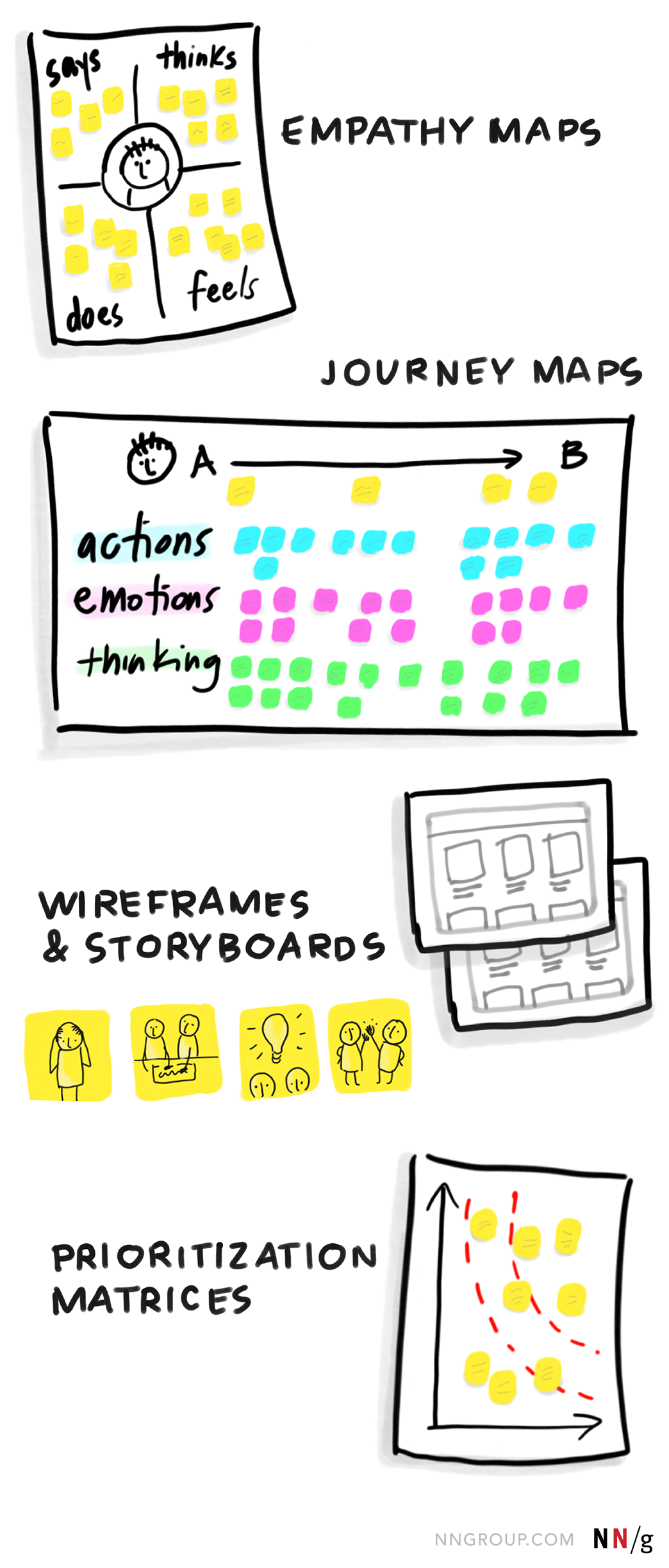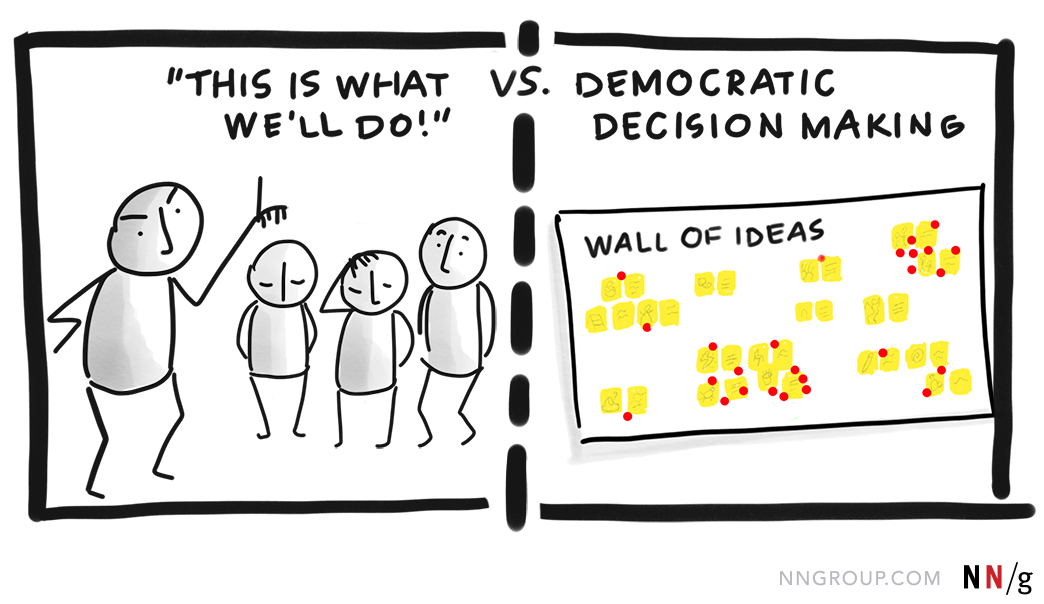No company can succeed on the brainpower of one person. Teams are the foundation of a successful workplace. But working in teams can have a fairly large cost: members must spend time building common ground — that is, a body of common knowledge, assumptions, vocabulary, and cultural practices. In strong teams, the common ground has already been established and the overhead of communication is outweighed by the benefits of collaboration. As a result, these teams are able to be not only efficient, but also produce high-quality, fruitful outputs.
How can companies support the process of building common ground in teams? Design thinking is a creative problem-solving approach that not only helps develop innovative solutions, but it can also facilitate the creation of common ground.
Design thinking develops 3 significant components of common ground in teams:
- Shared vocabulary
- Tangible artifacts
- A trust-based team culture
Shared Vocabulary
The inability to communicate efficiently is at the core of many teaming issues. Individuals often have different interpretations for the same concept or idea, due to their varied backgrounds and experiences. For example, team members who are experts in different disciplines may bring clashing industry jargon, practices, or expectations. Contradictory interpretations of fundamental notions hinder team efficiency and create unnecessary animosity and frustration.
Simply put, teams can only move as quickly as they can successfully communicate. The collaborative nature of design thinking circumvents this friction by involving all team members from the very beginning in a workshop-based approach. As the whole team moves through key exercises together, a shared vocabulary organically develops and the common ground begins to be built. When teams have a shared vocabulary, the focus can move from what to how.

This shared vocabulary comprises words, concepts, ideas that refer to common team experiences and processes. For example, during the empathize phase of design thinking, the team strives to understand what users think and do when they try to accomplish a specific goal — “Sam is our new user and feeling inadequate because he can’t figure out what sign-up question field he left empty” or “Sam is scrolling up and down the page over and over.” As the entire team gets to know this user, it develops a shared, unambiguous understanding of who the user is and what he or she needs.
Later on in the process, “Sam” becomes a shortcut for a new user that needs assistance during signup. Note that at this stage “Sam” is not yet a persona, but a specific user in a specific scenario. Personas are user descriptions that can be applied to a variety of scenarios. However, as more knowledge, insight, and user data is accumulated, Sam may develop into a persona. In this instance, the team would face little to no learning curve as they are already familiar with Sam.
Metaphors also help reinforce a shared vocabulary, especially as a team begins to identify a vision. They can convey abstract ideas or goals by rooting them in simple, clear analogies. A metaphor might align a team on a common goal, without the need to prescribe an exact feature set or solution. Imagine a team ideating on how to help users learn a new site feature. “We want to help our users like a teacher’s assistant helps students — remaining out of sight for those who get it immediately, but there to give step-by-step guidance to those who struggle.”
While certain roles on the team would be responsible for figuring out how the metaphor exactly manifests in the product, the whole team — from sales to management — can immediately agree on how the experience should feel. This shared understanding becomes a significant advantage as the team moves forward with the project.
Tangible Artifacts
A key principle of design thinking is “show, don’t tell.” Throughout the design-thinking process, the team produces several tangible artifacts: empathy maps, journey maps, storyboards, and wireframes, to name a few.

The artifacts created when practicing design thinking have a wide range of team benefits such as:
- Facilitating visualization of complex ideas
Visualization is a tool that transcends cultures and languages. Using imagery reduces the risk of misalignment because everyone then has a visual baseline. This especially applies to abstract concepts that may be less intuitive and harder to grasp. Stories, wireframes, prototypes, videos, even low-fidelity mockups are more likely to successfully convey an idea than just words.
- Providing a physical dictionary for the team’s shared vocabulary
The artifacts represent the organizational memory of the team and serve as a fixed, persistent reference point for the team. They are the physical manifestation of the team’s vocabulary and can clarify further ambiguities and misunderstandings. Members can go back and refer to those common visuals to make sure they did not deviate from the common ground that the team has built so far.
- Building group cohesion
When groups have tangible outcomes that they can refer to, they become more closely tied, more likely to see themselves as successful, and more committed to the collaboration. Each artifact that was produced as part of the team effort counts as a point won by the team, and increases team strength.
Trust-Based Team Culture
Design thinking is inherently democratic by:
- Relying on cross-disciplinary and cross-hierarchical participation
- Balancing each participant’s contribution so that all ideas are weighed equally
- Supporting divergent, idiosyncratic thinking
Traditionally, organizational hierarchy plays a role in whose ideas and opinions are heard. Too often, companies use the “hippo design methodology” (make decisions based on the highest-paid person’s opinion) and the loudest voice or the highest rank wins. In the design-thinking process, team members use sticky notes to write down their ideas and no individual’s idea is larger or louder. As ideas are put up on the wall, they each carry equal weight and are anonymous. This method equally favors introverts and extroverts, bosses and subalterns.
In the design-thinking process, ideas are also evaluated democratically. Team members read others’ proposals silently rather than being persuaded or impacted by what others may think. Next, participants place stickers near the ideas that resonate the most with them. Each team member casts the same number of votes. From there, the wall becomes a heat map visible to everyone, and the solutions with most votes move forward. Thus, the decision-making process is in the open, and based on majority voting rather than the opinions of any one individual. The wall also becomes a valuable tangible artifact, that documents the team history and process. Anyone can glance at the wall and understand what the team collectively agrees on.

Democratic decision-making processes in which everybody has a voice build a positive, trust-based team culture and motivate members to participate and make their opinions heard. They also build expectations and instill healthy collaboration practices, which pave the way for even better future communication.
Conclusion
The design-thinking process brings team members together, focuses them on a shared, unambiguous goal instead wasting endless time stuck in disagreement. The collaborative culture created during design thinking motivates employees, improves job satisfaction and retention, and further increases the probability of a fruitful outcome.
Let me be clear: the main goal of design thinking is to promote innovation and creativity, not to build strong teams. But one of its commonly forgotten benefits is that it can help establish the climate needed to build a strong, high-performing team committed to the collaboration.
Learn more about design thinking in the full-day course Generating Big Ideas with Design Thinking.




